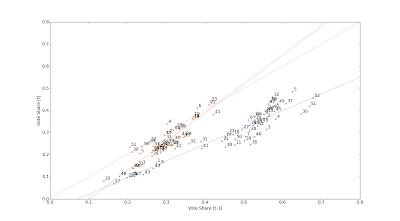Our second attempt to construct the fundamental model was
based on a simple premise: the relative positions of electoral districts are predictable from previous elections. This is also the case for the
Spanish provinces. Figure 1 considers the elections of 2000 (t-1) and 2004 (t) and Figure 2 that of 2008 (t-1) and 2011 (t). Each figure plots the electoral result on t-th election versus that on the (t-1)-th election for the
Popular Party (blue) and the Socialist party (red) for each province in Spain. The numbering of the provinces follows the standard postcode coding of Spanish provinces. Each figure include the straight 45 degrees line in gray, and (robust) regression lines one for each party.
Figure 1.
Figure 2.
Both figures show that the shares of votes in each province lie
nicely on almost parallel straight lines. The movement up or down with respect to the
45 degrees line depend on the evolution of the “national sentiment” which can
be estimated from national polls. Obviously, there is also noise that needs to
be modeled, and the influence of provinces with local nationalist parties.
This approach is particularly interesting in the Spanish
case in which we have many national polls, but we do not have regular electoral
districts (provincial) polls in contrast with, for instance, the wealth of US state
polls. We could use historical data on the relative position of each province, within a fundamental model, and national polls data, which will inform about the national drift for every party, to predict the electoral at provincial level for each party. However, this approach is hindered by the recent change of political scenery in Spain, as a result of the rise of popularity of two new parties, C’s
and Podemos. Figure 3
shows that the stability of the relationship between the provincial shares for PP and PSOE
was broken in the latest elections.
Figure 3.
Therefore, this second approach, although promising in other
situations, it is also subject to important problems of instability of the
estimates due to the entrance of new parties in the political competition. The search continued…



